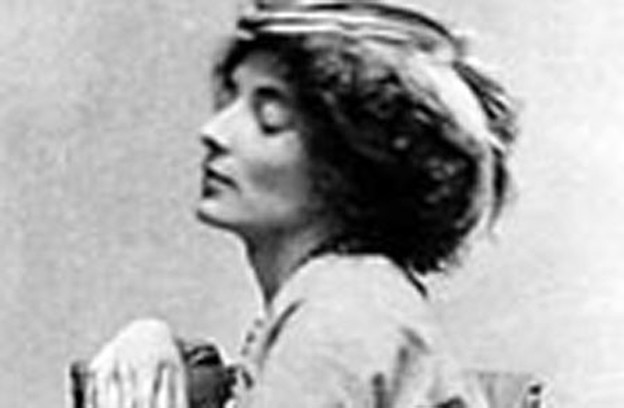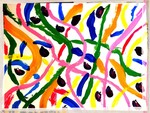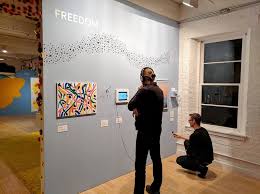Walls of this poetry
On Mina Loy, the children again, and 'Come to Your Senses'

Poetry is prose bewitched, a music made of visual thoughts, the sound of an idea. — Mina Loy
In her meditation, poet Mina Loy turns to multiple arts and genres to explain a process of osmosis as poetry. From utilizing words like “bewitched” to describing “music made of visual thought” and ideas “as sound,” Loy translates poetry into other forms of the imagination in order to define it. It may not be surprising that Loy, who was not only a poet, but also an actress, playwright, feminist, futurist, and lamp maker, turned to multiple genres of art and thought. Her definition angles towards a fourth dimension of the magical, indescribable, and ephemeral. In the collection The Lost Lunar Baedeker: Poems of Mina Loy, edited by Roger Conovor, Loy wasn’t only concerned with writing poetry; she was concerned with understanding it. She meditates on poetry through explanation. For example, in “Modern Poetry,” an essay included in the book, and where the above quote is drawn from, Loy seems to be contemplating the definition of poetry not only as literature above ordinary language, but something not of this world, transmuted. Perhaps what is so special about Loy and her enduring impact on feminist poetics includes how she also theorized poetry as a woman poet. In doing so, she drew upon her interests in other forms of expression such as activism, music, and prose.

In this series, I hope to also understand poetry by turning towards differing genres of art. Like many, I’ve wondered often about the hard-lined boundaries between the arts and humanities. Perhaps in these political times, I’m becoming more attuned to a commitment to the transgressive. Promiscuous thinking and writing, as stated by Deleuze and Guattari, is a political act. Investigating the spaces where poetry touches other art, and vice versa, I hope, not only helps us to understand poetry, but lends itself to an examined life we all hope to live.
Because I work in new media art and teach and write on film, alongside other forms of art and theory, it’s not a surprise as to why I’ve returned to Loy after a fateful day of discovering her work in a modernist poetry course as an undergraduate. While studying with Marjorie Perloff, the poems of Yeats and Williams, poets I still adore, shaped my poetics. However, Loy offered something different. If you’ve studied Loy in college like I did, her poetics and enjambments rise up from the pages of the Norton Anthology like hallucinatory air. The evocative ordering that awakens the act of reading through everyday splendor. A contained excess. Ornate and yet so simple. Loy offered a different kind of travel guide, that made the ordinary world so much more ordinary and different like the moon — yes, I imagine dancing on the moon to be calming because of the dynamics of gravity.
“I love poetry,” the children exclaimed. “Poetry makes me so calm!”
Previously, in my post on visiting an elementary school in Cambridge to read poetry, I neglected to include another part of the visit because in many ways it was not worth mentioning. Because before I read the poems from my book, I brought with me a worksheet. I created this worksheet with definitions of poetry and a powerpoint to help the children understand. Unbeknownst to me, the printing services were down that day, and I asked a helpful administrator at Harvard to help me print the copies while I pleaded with my partner to take after the forms, to ensure I didn’t mispell, for example. I took this workshop for children seriously, and he was happy to do so as I was visiting his child’s classroom, a child I now love. I felt could not simply go to the classroom and just read poetry. I felt I needed the worksheets to help the children understand.
Worksheets that included words that define poetry, such as metaphor, simile, onomatopoeia, alliteration — all sixteen-point font! Poetry!
However, when I arrived ready to give a ten-minute lesson on poetry, the children were less interested in learning about metaphor. They seemed to be perplexed, crinkling their small noses with sweet expressions of confusion. As I described earlier, their delight and declarations of “I love poetry; poetry makes me feel so calm” occurred only when poetry was read to them. Later, when the teacher passed around the book, one child looked pensively at the pages, and said, this seem like a good book. Endearing, yes, and yet the worksheets and the terms seemed to mean nothing. And it was reading poetry to them that meant something. It was then they began to understand.
When I think back to what happened, perhaps I’m reminded of something I’ve long suspected while studying poetry over the years. While my teaching skills for an elementary school group may be less than experienced — I’ve only taught college-aged students — I can’t help to think it’s something else. The worksheets were not enough to teach poetry. They seemed actually contrary to defining poetry for the children. And children, I feel, have an intelligence that far surpasses adults with advanced degrees.
In the grown-up world, poetry becomes something. Poetry is something studied, something written, then canons, tenure lines, official documents, and dare I say, even wars, needless poetry wars. Spurring out anthologies, fields, journal issues, and arguments over a well-meaning dinner of poets at a poetry retreat, for example. True story. (I wasn't involved!)
I turn to children in their innocence, imagination, play, and intellingence, as it seems to brings us back to something else about poetry. Not an explanation, but a messy exploration.
***
This was a long and meandering way to discuss a recent exhibition I saw at the MASS MoCA in North Adams which raises similiar questions in regards to children, poetry, and definitions. I begin with Loy’s explanation and the children of Cambridge Elementary School because I want to discuss the children’s art exhibition Come to Your Senses at MASS MoCA that I viewed this spring. The children’s exhibition Come to Your Senses was in the lively “Kidspace” gallery at the expansive museum. In the installation, visual artists, poets, dancers, musicians, perfumers, chefs, and sculptors were asked to use one another’s art as a catalyst to create their own work.


Come to Your Senses, MASS MoCA.
The founder of the three-year-long project, artist Sally Taylor, invited artists of various mediums and genres to ask them to interpret one another’s art and then express a translation into their own medium. Like an artistic game of telephone, the art is transmuted into other art forms, teaching children the ways expression can be embodied in diverse genres. For example, a musician interprets a painting into song, a dancer interprets the painting into movement, a chef creates a dish based on the movement, a poet creates a poem from the embodied act, etc. Each artist uses the work to catalyze their own creativity and in the “language of their own medium.” Engaging all five senses, the project reveals the exciting ways genres and mediums can mutate and catalyze one another.
At “Kidspace” and in this particular rendition of the project, the initial works of art were created by actual students in North Adams, Massachusetts. Adult artists interpreted the children’s artwork and responded back in kind. The installation was delightful, and I thought it was an exciting way to introduce the arts — in its many forms — to children. And while poetry was included in this creative game as well as a brownie, one may ask whether, if we think back to Loy, we could see each piece as poetry. How do we make sense of the space between each artwork? Before the art handlers mounted the black audio speakers that recited poetry on the white walls, or the the glass jar of brownie, what is left in between? Is that poetry? There in the white wall now and between each part, is there meaning? Myung Mi Kim’s poetry certainly teaches us this:
There is meaning in white space.
Like Loy, I’m interested in an expansive definition of poetry and the possibilities of poetry (machines) for children and our futures.
There are parallels between the installation and Loy’s definition. Like the space between the artworks on the white wall, I’m interested in the betweenness that occurs in her definition — the ways the space between “bewitched” and “a,” and “thoughts” and “the,” which demark where poetry ends and music begins.
***
Our futures, in this bleak political moment, are like walls that don’t hold meanings now unless we forge forward to raise them. I’m interested in the edges — and yes, walls — of this poetry.
Automated Poetics